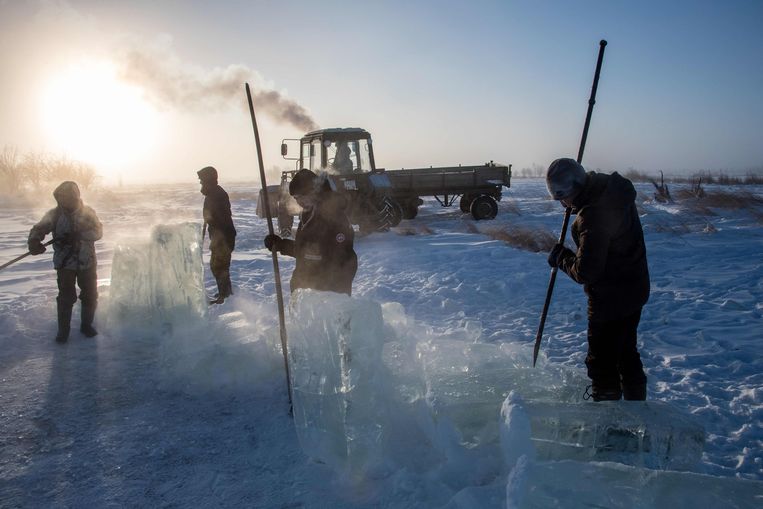Melting permafrost is not only causing an increase in greenhouse gas emissions, but also has dire consequences for infrastructure in the Arctic. Research shows that apartment buildings are collapsing, and homes are sinking into the sea.
Scientist Monique Heijmans hasn’t been to northeastern Siberia for three years yet, researching the vegetation of the frozen bottom. Hold her heart. What will the area look like when you come back? Changes are rapid in the Arctic. “When I read that the temperature is 38 degrees Celsius in northeastern Siberia, I am very worried.”
Therefore, the results of studies on permafrost are clear. Heijmans contributed to a special edition of Nature Reviews Earth and Environment Where current information about semi-permanently frozen soil is displayed again. Three visions.
1. Melting permafrost causes apartments to collapse and homes to sink into the sea
In the Siberian city of Yakutsk, where the temperature easily reaches minus 40 degrees Celsius in winter, all houses are built on stilts or concrete blocks. It prevents heat from homes from transferring to the ground and heating the permafrost beneath. Everything to prevent the rocky bottom from melting and turning into an unstable plain. This is not always enough: often a house, apartment building or school collapses. 1 in 10 buildings in this Russian city are already damaged.
On the Arctic coast, the situation is even more dangerous. There, the residents literally see their villages slip into the sea. In the Northern Hemisphere alone, permafrost regions include at least 120,000 buildings, 40,000 km of roads and 9,500 km of pipelines. 70 percent of that infrastructure is built on rapidly thawing permafrost and is at high risk of being damaged by 2050. Yet more is still being built: Russia is taking full advantage of the economic opportunities that climate change brings.
So engineers are working on ways to do this as responsibly as possible. With pumps that extract heat from the ground, for example, and surges that have been mandatory in Yakutsk since the 1960s. But climate-adapted construction costs money, especially if you assume a worst-case scenario, which is not so plentiful in Siberian parts of Russia. In the meantime, the melting continues unabated.
2. Melting began everywhere, but the local differences are great
On temperature maps, the Arctic always turns dark red. The temperature is rising twice as fast as the average on Earth. So the frozen ground, the permafrost, is also warming everywhere. The differences are significant, from 0.2 °C to 3 °C per decade locally.
It is largely unclear where these differences come from. Location plays a major role, as does disturbances small and large, such as wildfires and human presence. Even a small disturbance has a huge impact. Heijmans: Although the locals warned us about this, we took the same route to our search site each time. Our steps made the road melt faster than the ground next to it.
The type of permafrost also appears to be an important factor, says Jurian Funk, a researcher at VU University Amsterdam. Not all permafrost contains the same amount of ice. When almost ice-free permafrost thaws, the structure of the soil is preserved. On the other hand, if a large amount of ice melts, the water runs out and sinks into the ground. This place can never freeze the same way again.
3. It goes fast, but the exact speed is hard to predict
Open the freezer door and it may take a long time to thaw. The same applies to permafrost: it does not disappear immediately after the temperature of the outside air rises. We may be thousands of years away before that happens, Funk says. However, it is now clear that this gradual process does not always apply locally.
For example, due to forest fires, which increasingly cause permafrost to ignite. Or landslides caused by unstable ground which then exposes more permafrost, which thaws faster. Thaw lakes, which form when permafrost melts, are major sources of methane, a greenhouse gas 86 times more powerful than carbon dioxide. Or the thickening melt layer, in which all kinds of microorganisms work at temperatures above zero to turn plant residues into greenhouse gases.
While the global ecosystem still appears to be absorbing more greenhouse gases than it emits, the Intergovernmental Panel on Climate Change warns of a turning point in its latest climate report. At that moment, this net balance changes; Permafrost becomes a greater source of greenhouse gases than a reservoir. Permafrost thaw is not only a consequence of climate change, but also a cause. The self-reinforcing vicious cycle is complete.
However, there are also inhibitory factors. The focus of Heijmans’ research was vegetation, which appeared to slow snowmelt. It grows more on warmer permafrost. Shrubs, for example, provide shade, so that less heat from the sun penetrates into the ground. Plants also trap the cold in the ground when the air becomes warmer.
Thus, determining whether this tipping point is on the horizon is not entirely clear. But there is no doubt that permafrost changes dramatically. We can limit the consequences with good climate policy, but it’s really impossible to stop completely and, says Funk, it’s already started. Climate change in the Arctic is much faster, more extreme, and more unpredictable than here. The people there are basically asking: How are we going to live with it?

“Coffee buff. Twitter fanatic. Tv practitioner. Social media advocate. Pop culture ninja.”











More Stories
Which can cause an increase in nitrogen.
The Central State Real Estate Agency has no additional space to accommodate Ukrainians.
The oystercatcher, the “unlucky national bird,” is increasingly breeding on rooftops.